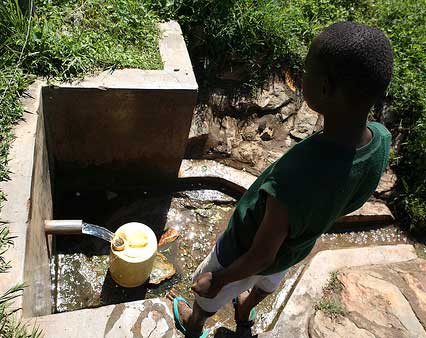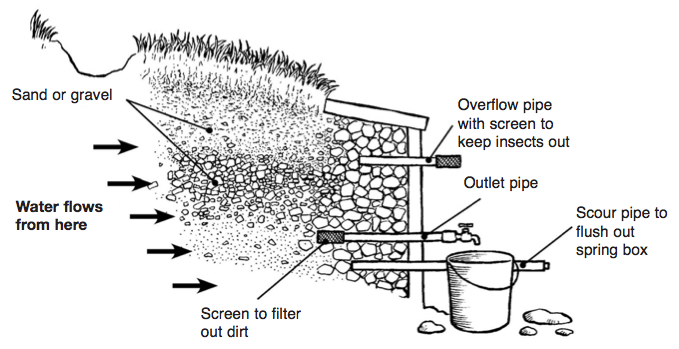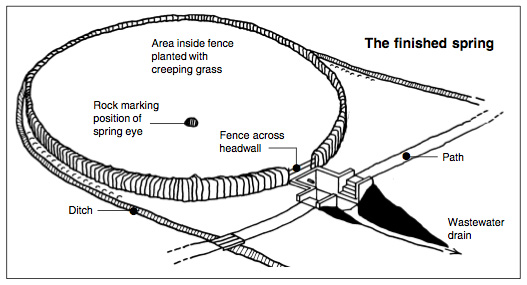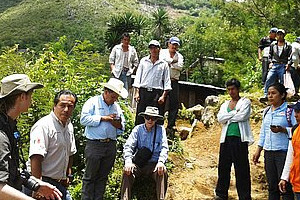Difference between revisions of "Water Portal / Rainwater Harvesting / Surface water / Springwater collection"
| Line 1: | Line 1: | ||
[[Image:springwater icon.png|right|80px]] | [[Image:springwater icon.png|right|80px]] | ||
[[Image:Springwater Collecting.jpg|thumb|right|200px|Kenyan boy gathers water from a protected spring in Busia. <br> Photo: [http://www.povertyactionlab.org/evaluation/cleaning-springs-kenya The Abdul Latif Jameel Poverty Action Lab.]]] | [[Image:Springwater Collecting.jpg|thumb|right|200px|Kenyan boy gathers water from a protected spring in Busia. <br> Photo: [http://www.povertyactionlab.org/evaluation/cleaning-springs-kenya The Abdul Latif Jameel Poverty Action Lab.]]] | ||
| − | [[Image: | + | [[Image:Springwater Collection 2.jpg|thumb|right|200px|Children collecting spring water in Lamahai, Nepal. Photo: [http://worldwildlife.org/places/eastern-himalayas WWF.]]] |
| − | + | ||
There are several types of systems that can be built to exact water from a spring. The most common is to build a spring box, but a lower cost and simpler in design alternative is the [http://www.lboro.ac.uk/well/resources/technical-briefs/34-protecting-springs.pdf protection of a spring with no box]. Protecting a spring without a box is cheaper than digging a well or borehole, but spring boxes are more useful as storage when demand is greater than the flow, to prevent contamination, and providing the spring with an easy way to flow into a pipe. | There are several types of systems that can be built to exact water from a spring. The most common is to build a spring box, but a lower cost and simpler in design alternative is the [http://www.lboro.ac.uk/well/resources/technical-briefs/34-protecting-springs.pdf protection of a spring with no box]. Protecting a spring without a box is cheaper than digging a well or borehole, but spring boxes are more useful as storage when demand is greater than the flow, to prevent contamination, and providing the spring with an easy way to flow into a pipe. | ||
Revision as of 00:21, 20 September 2014

Photo: The Abdul Latif Jameel Poverty Action Lab.
There are several types of systems that can be built to exact water from a spring. The most common is to build a spring box, but a lower cost and simpler in design alternative is the protection of a spring with no box. Protecting a spring without a box is cheaper than digging a well or borehole, but spring boxes are more useful as storage when demand is greater than the flow, to prevent contamination, and providing the spring with an easy way to flow into a pipe.
Often, in rural areas, central water filters are installed at the source, which supply water to several houses. Generally these are unprotected, and at unattended hours even pigs bathe in the sole source of drinkable water. Often springs have slow flow rates and so are not suitable for water pipe or network systems. At those places, it is wiser to protect the spring well and set up a manual pump. This keeps the water clean, and can increase the water supply. Once a spring is protected it is relatively easy to run pipes (if the flow is big enough) and create a tap, using gravity to power the flow if possible, from the spring closer to the community.
Contents
Suitable Conditions
The system is suitable for water sources at small springs. It can be adapted depending on the flow rate and size of the filter, the amount of water demanded, and other conditions.
So it follows that: If water from a spring can be protected and collected without a spring box; if no sedimentation is needed because the water carries only a low level of suspended solids; if no storage is needed because the water flows at a rate sufficient to meet the peak demand... then no spring box is required.
Contamination check
To know if a spring is safe, find the true source of the spring – where it comes out of the ground – and ask these questions:
- Is there a stream or other surface water that goes underground above the spring? If so, what appears to be a spring may in fact be surface water that flows a short distance underground. In this case, it will likely be contaminated or may flow only during the rainy season.
- Are there large openings in the rock above the spring? If so, check the water in the spring after a heavy rain. If it appears very cloudy or muddy, contamination from surface runoff is likely.
- Is there a possibility of contamination from human or animal wastes near or just above the source of the spring? This could include pastures for livestock, pit toilets, septic tanks, or other human activity.
- Is the soil very loose or sandy within 15 metres of the spring? This could allow contaminated surface runoff to enter the groundwater.
| Advantages | Disadvantages |
|---|---|
| - Spring water has good quality and may not need treatment - When taken by gravity, operation & maintenance costs reduce due to no need for pumping |
- Water available is limited to spring yield |
Resilience to changes in the environment
Drought
Effects of drought: Can dry up.
Underlying causes of effects: Less recharge of aquifer due to less rainfall; Size of aquifers limited; Increasing population and water demand.
To increase resiliency of WASH system: Improve flow by excavating carefully at spring eyes; A holding reservoir can be constructed to bridge peak demand, or a lined pond provides a way to store larger quantities during all the hours of flow; Design for dry season flow rates.
More information on managing drought: Resilient WASH systems in drought-prone areas.
Floods
Heavy surface flows may damage a spring box (that was poorly constructed) or its surrounding protections, and create more turbidity in the springwater.
Construction, operation and maintenance
General advice on cement: A common cause of cracks in structures and linings (e.g. in tanks, dams, waterways, wells) is errors in mixing and applying the cement. First of all, it is important that only pure ingredients are used: clean water, clean sand, clean rocks. The materials have to be mixed very thoroughly. Secondly, the amount of water during mixing needs to minimal: the concrete or cement needs to be just workable, on the dry side even, and not fluid. Thirdly, it is essential that during curing the cement or concrete is kept moist at all times, for at least a week. Structures should be covered with plastic, large leaves or other materials during the curing period, and kept wet regularly.
Construct a spring:

Click image for details. Drawing: PACE, Spring protection.

Click image for details. Drawing: PACE, Spring protection.
A spring box (or spring protection only) is very easy and cheap to build. It can be adapted to different water sources by altering the design slightly.
First you must clean the filter from any loose material (sticks, stones, garbage, etc) and dig out the mud so there is enough space. Then place one or more ferrocement tanks in the hole. The tanks have bore holes through which water flows in. Around the tank, build a filter of arranged large stones. This space is then filled with water and it serves as an additional reservoir. Then attach the guide pipe to the tank, into which the pump will later be placed.
On top of the large stones, place a layer of small stones, and then gravel. Then the surface must be flattened and a polyethylene film (nylon, oilcloth) arranged on it. On top of this, refill the hole with earth. The earth should be made wet so it becomes compact and stable. This earth must then be covered with another waterproof layer, such as cement. The surface should be slightly sloped, to avoid stagnant waters. To prevent stones turning loose, spread an additional cement layer, mainly around the pump, so no infiltration fissures may appear. For an additional platform for the pump, an old tire may be used. Finally introduce the pump into the guide pipe.
If the spring is larger, it can be protected by an arch over the spring eye (where the water first comes out). Instead of the ferro cement tank, build a cavern with stones or with bricks. Usually, an arched board is used, on which stones are arranged. With this mold, you move forward line by line along the board. When the stones of each segment have been arranged, a cement mortar is spread in the space between stones or bricks, to fix the arch or vault. Also, for areas of water scarcity, any unused overflow water can be captured and stored in a pond or tank with impermeable lining to be used for irrigation purposes as and when needed.
Maintenance
Spring boxes need to be monitored to ensure that the spring continues to provide safe water. Silt, leaves, dead animals and other things can collect in the pipes and spring box and block the pipes or contaminate the water. Putting a wire screen on the pipe leading into the spring box will prevent unsafe things from entering pipes. Cleaning the screen every now and again will ensure a steady flow of water.
Other considerations
A fence should be constructed 10m above spring eye and around the water collection area to keep out animals. A cut-off drain 10m above the spring eye will reduce possible contaminated runoff from reaching the spring eye. Planting trees near the spring will protect it even more, prevent erosion, and make it a more pleasant place to collect water.
A holding reservoir is not always necessary. It can be constructed if dry season flow rate is insufficient to meet peak demand from users, or it might be a wise investment with decreasing reliability of spring flows. Size of reservoir to be determined according to balance between constant inflow and peak outflow rates.
Try to take water away from spring eye to avoid damaging it by back pressure or foundation works. Water ideally should be taken downhill from spring eye to an outlet.
An effective hand pump that can be used to extract water from a spring is an EMAS pump. EMAS is the acronym for Escuela Móvil de Agua y Saneamiento (Mobile School for Water and Sanitation), in Bolivia, whose director, Wolfgang Eloy Buchner, developed the EMAS pump in the 1990's. EMAS is not only the name of the mobile school for water and sanitation, but also a whole technical and social concept of water and sanitation which includes rain water harvesting, solar water heaters, windpower, hydraulic rams, water treatment, small tanks and sinks, a variety of hand and foot pumps, and ferrocement tanks. The aim of the technologies and systems is to achieve the necessary supply of drinkable water, and water for micro irrigation in rural and sub urban areas. EMAS system of pumping.
Costs
In remote areas, use of plastic tanks can save money and labour days. 10 years of experience in Lao PDR showed that the best compromise between quality and amount of work was to make the intake with concrete, all tanks (sedimentation, break pressure or reservoir) from plastic tanks buried underground, and concrete tapstands. Using a combination of plastic and concrete (rather than only concrete for everything) saved about half the number of labour days. In terms of cost, the combination option was 8% more expensive but cheaper if free village labour was factored in.
Field experiences
In the sub-urban areas of Kampala city, springs are a major source of water for domestic use. Though spring water is considered to be aesthetically acceptable for domestic use, presence of poorly designed pit latrines, poor solid waste management as well as poor and inadequate spring protection, may lead to contamination of spring water with pathogenic bacteria.
Read more on this study in Uganda: The quality of water from protected springs in Katwe and Kisenyi parishes, Kampala city, Uganda.
 WASH Alliance project, AMREF in Ethiopia |
 MWA-LAP: Mexico |
Manuals, videos and links
- Protecting Springs or (alternative link), produced by WEDC, Loughborough University.
- Spring Protection, Action sheet 19. by PACE.
- Spring Protection by WaterAid.
Acknowledgements
- CARE Nederland, Desk Study: Resilient WASH systems in drought-prone areas. October 2010.
- Protecting Springs or (alternative link), produced by WEDC, Loughborough University.
- Spring Protection, Action sheet 19. by PACE.
